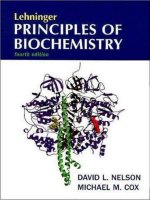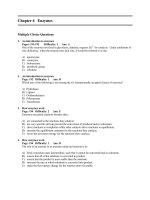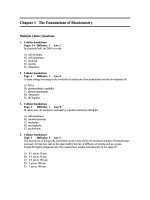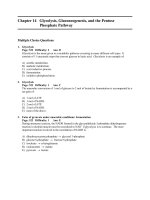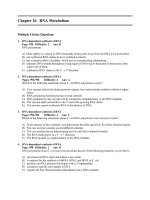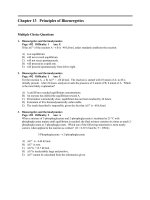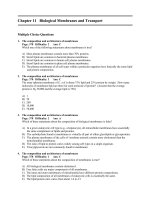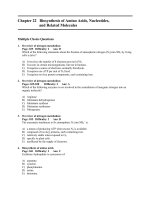kupdf com lehninger principles of biochemistry test bank ch 17pdf
Bạn đang xem bản rút gọn của tài liệu. Xem và tải ngay bản đầy đủ của tài liệu tại đây (177.52 KB, 12 trang )
Chapter 17 Fatty Acid Catabolism
Multiple Choice Questions
1. Digestion, mobilization, and transport of fats
Page: 632 Difficulty: 2 Ans: A
Lipoprotein lipase acts in:
A)
B)
C)
D)
E)
hydrolysis of triacylglycerols of plasma lipoproteins to supply fatty acids to various tissues.
intestinal uptake of dietary fat.
intracellular lipid breakdown of lipoproteins.
lipoprotein breakdown to supply needed amino acids.
none of the above.
2. Digestion, mobilization, and transport of fats
Page: 634 Difficulty: 2 Ans: B
Free fatty acids in the bloodstream are:
A)
B)
C)
D)
E)
bound to hemoglobin.
carried by the protein serum albumin.
freely soluble in the aqueous phase of the blood.
nonexistent; the blood does not contain free fatty acids.
present at levels that are independent of epinephrine.
3. Digestion, mobilization, and transport of fats
Page: 634 Difficulty: 2 Ans: C
The role of hormone-sensitive triacylglycerol lipase is to:
A)
B)
C)
D)
E)
hydrolyze lipids stored in the liver.
hydrolyze membrane phospholipids in hormone-producing cells.
hydrolyze triacylglycerols stored in adipose tissue.
synthesize lipids in adipose tissue.
synthesize triacylglycerols in the liver.
4. Digestion, mobilization, and transport of fats
Pages: 635-636
Difficulty: 1 Ans: A
Transport of fatty acids from the cytoplasm to the mitochondrial matrix requires:
A)
B)
C)
D)
E)
ATP, carnitine, and coenzyme A.
ATP, carnitine, and pyruvate dehydrogenase.
ATP, coenzyme A, and hexokinase.
ATP, coenzyme A, and pyruvate dehydrogenase.
carnitine, coenzyme A, and hexokinase.
Chapter 17 Fatty Acid Catabolism
199
5. Digestion, mobilization, and transport of fats
Page: 636 Difficulty: 2 Ans: A
Fatty acids are activated to acyl-CoAs and the acyl group is further transferred to carnitine because:
A)
B)
C)
D)
E)
acyl-carnitines readily cross the mitochondrial inner membrane, but acyl-CoAs do not.
acyl-CoAs easily cross the mitochondrial membrane, but the fatty acids themselves will not.
+
carnitine is required to oxidize NAD to NADH.
fatty acids cannot be oxidized by FAD unless they are in the acyl-carnitine form.
None of the above is true.
6. Digestion, mobilization, and transport of fats
Page: 636 Difficulty: 2 Ans: C
Carnitine is:
A)
B)
C)
D)
E)
a 15-carbon fatty acid.
an essential cofactor for the citric acid cycle.
essential for intracellular transport of fatty acids.
one of the amino acids commonly found in protein.
present only in carnivorous animals.
7. Digestion, mobilization, and transport of fats
Page: 636 Difficulty: 2 Ans: B
Which of these is able to cross the inner mitochondrial membrane?
A)
B)
C)
D)
E)
Acetyl–CoA
Fatty acyl–carnitine
Fatty acyl–CoA
Malonyl–CoA
None of the above can cross.
8. Oxidation of fatty acids
Pages: 637-638
Difficulty: 2 Ans: C
What is the correct order of function of the following enzymes of β oxidation?
1. β-Hydroxyacyl-CoA dehydrogenase
2. Thiolase
3. Enoyl-CoA hydratase
4. Acyl-CoA dehydrogenase
A)
B)
C)
D)
E)
1, 2, 3, 4
3, 1, 4, 2
4, 3, 1, 2
1, 4, 3, 2
4, 2, 3, 1
200
Chapter 17 Fatty Acid Catabolism
9. Oxidation of fatty acids
Page: 639 Difficulty: 2 Ans: D
If the 16-carbon saturated fatty acid palmitate is oxidized completely to carbon dioxide and water (via
the β-oxidation pathway and the citric acid cycle), and all of the energy-conserving products are used
to drive ATP synthesis in the mitochondrion, the net yield of ATP per molecule of palmitate is:
A)
B)
C)
D)
E)
3.
10.
25.
108.
1,000.
10. Oxidation of fatty acids
Page: 639 Difficulty: 2 Ans: C
Saturated fatty acids are degraded by the stepwise reactions of β oxidation, producing acetyl-CoA.
Under aerobic conditions, how many ATP molecules would be produced as a consequence of removal
of each acetyl-CoA?
A)
B)
C)
D)
E)
2
3
4
5
6
11. Oxidation of fatty acids
Pages: 634-639
Difficulty: 2 Ans: B
Which of the following is (are) true of the oxidation of 1 mol of palmitate (a 16-carbon saturated fatty
acid; 16:0) by the β-oxidation pathway, beginning with the free fatty acid in the cytoplasm?
1. Activation of the free fatty acid requires the equivalent of two ATPs.
2. Inorganic pyrophosphate (PPi) is produced.
3. Carnitine functions as an electron acceptor.
4. 8 mol of FADH2 are formed.
5. 8 mol of acetyl-CoA are formed.
+
6. There is no direct involvement of NAD .
A)
B)
C)
D)
E)
1 and 5 only
1, 2, and 5
1, 2, and 6
1, 3, and 5
5 only
Chapter 17 Fatty Acid Catabolism
201
12. Oxidation of fatty acids
Pages: 634-639
Difficulty: 1 Ans: D
Which of the following statements apply (applies) to the β oxidation of fatty acids?
1. The process takes place in the cytosol of mammalian cells.
2. Carbon atoms are removed from the acyl chain one at a time.
3. Before oxidation, fatty acids must be converted to their CoA derivatives.
+
4. NADP is the electron acceptor.
5. The products of β oxidation can directly enter the citric acid cycle for further oxidation.
A)
B)
C)
D)
E)
1 and 3 only
1, 2, and 3
1, 2, and 5
3 and 5 only
4 only
13. Oxidation of fatty acids
Pages: 634-636
Difficulty: 3 Ans: D
Which of the following statements concerning the β oxidation of fatty acids is true?
A) About 1,200 ATP molecules are ultimately produced per 20-carbon fatty acid oxidized.
B) One FADH2 and two NADH are produced for each acetyl-CoA.
C) The free fatty acid must be carboxylated in the β position by a biotin-dependent reaction before
the process of β oxidation commences.
D) The free fatty acid must be converted to a thioester before the process of β oxidation
commences.
E) Two NADH are produced for each acetyl-CoA.
14. Oxidation of fatty acids
Pages: 635-639
Difficulty: 3 Ans: A
The balanced equation for the degradation of CH3(CH2)10COOH via the β-oxidation pathway is:
A) CH3(CH2)10COOH + 5FAD + 5NAD+ + 6CoA—SH + 5H2O + ATP →
6 Acetyl-CoA + 5FADH2 + 5NADH + 5H+ + AMP + PPi
B) CH3(CH2)10COOH + 5FAD + 5NAD+ + 6CoA—SH + 5H2O →
6 Acetyl-CoA + 5FADH2 + 5NADH + 5H+
C) CH3(CH2)10COOH + 6FAD + 6NAD+ + 6CoA—SH + 6H2O + ATP →
6 Acetyl-CoA + 6FADH2 + 6NADH + 6H+ + AMP + PPi
D) CH3(CH2)10COOH + 6FAD + 6NAD+ + 6CoA—SH + 6H2O →
6 Acetyl-CoA + 6FADH2 + 6NADH + 6H+
202
Chapter 17 Fatty Acid Catabolism
15. Oxidation of fatty acids
Page: 638 Difficulty: 1 Ans: E
Which compound is an intermediate of the β oxidation of fatty acids?
A)
B)
C)
D)
E)
CH3—(CH2)20—CO—COOH
CH3—CH2—CO—CH2—CO—OPO32–
CH3—CH2—CO—CH2—OH
CH3—CH2—CO—CO—S—CoA
CH3—CO—CH2—CO—S—CoA
16. Oxidation of fatty acids
Page: 638 Difficulty: 2 Ans: A
The conversion of palmitoyl-CoA (16:0) to myristoyl-CoA (14:0) and 1 mol of acetyl-CoA by the βoxidation pathway results in the net formation of:
A)
B)
C)
D)
E)
1 FADH2 and 1 NADH.
1 FADH2 and 1 NADPH.
1 FADH2, 1 NADH, and 1 ATP.
2 FADH2 and 2 NADH.
2 FADH2, 2 NADH, and 1 ATP.
17. Oxidation of fatty acids
Page: 639 Difficulty: 2 Ans: C
Which of the following is not true regarding the oxidation of 1 mol of palmitate (16:0) by the βoxidation pathway?
A)
B)
C)
D)
E)
1 mol of ATP is needed.
8 mol of acetyl-CoA are formed.
8 mol of FADH2 are formed.
AMP and PPi are formed.
The reactions occur in the mitochondria.
18. Oxidation of fatty acids
Page: 639 Difficulty: 3 Ans: E
If an aerobic organism (e.g., the bacterium E. coli) were fed each of the following four compounds as
a source of energy, the energy yield per mole from these molecules would be in the order:
A)
B)
C)
D)
E)
alanine > glucose > palmitate (16:0)
glucose > alanine > palmitate
glucose > palmitate > alanine
palmitate > alanine > glucose
palmitate > glucose > alanine
Chapter 17 Fatty Acid Catabolism
203
19. Oxidation of fatty acids
Pages: 639, 642
Difficulty: 2 Ans: D
Which of the following is (are) true of the β oxidation of long-chain fatty acids?
1. The enzyme complex that catalyzes the reaction contains biotin.
2. FADH2 serves as an electron carrier.
3. NADH serves as an electron carrier.
4. Oxidation of an 18-carbon fatty acid produces six molecules of propionyl-CoA.
5. Oxidation of a 15-carbon fatty acid produces at least one propionyl-CoA.
A)
B)
C)
D)
E)
1, 2, and 3
1, 2, and 5
2, 3, and 4
2, 3, and 5
3 and 5 only
20. Oxidation of fatty acids
Page: 642 Difficulty: 2 Ans: E
14
The following fatty acid, in which the indicated carbon is labeled with C, is fed to an animal:
14
CH3(CH2)9COOH
After allowing 30 minutes for fatty acid β oxidation, the label would most likely be recovered in:
A)
B)
C)
D)
E)
acetyl-CoA.
beta-hydroxy butyryl-CoA.
both acetyl-CoA and propionyl-CoA.
palmitoyl-CoA.
propionyl-CoA.
21. Oxidation of fatty acids
Page: 642 Difficulty: 2 Ans: D
The carbon atoms from a fatty acid with an odd number of carbons will enter the citric acid cycle as
acetyl-CoA and:
A)
B)
C)
D)
E)
butyrate.
citrate.
malate.
succinyl-CoA.
α-ketoglutarate.
204
Chapter 17 Fatty Acid Catabolism
22. Oxidation of fatty acids
Page: 642 Difficulty: 2 Ans: B
In the disease sprue, vitamin B12 (cobalamin) is poorly absorbed in the intestine, resulting in B12
deficiency. If each of the following fatty acids were in the diet, for which one would the process of
fatty acid oxidation be most affected in a patient with sprue?
A)
B)
C)
D)
E)
CH3(CH2)10COOH
CH3(CH2)11COOH
CH3(CH2)12COOH
CH3(CH2)14COOH
CH3(CH2)18COOH
23. Oxidation of fatty acids
Page: 646 Difficulty: 2 Ans: D
During β oxidation of fatty acids, ___________ is produced in peroxisomes but not in mitochondria.
A)
B)
C)
D)
E)
acetyl-CoA
FADH2
H2O
H2O2
NADH
24. Oxidation of fatty acids
Page: 649 Difficulty: 2 Ans: B
When comparing the β-oxidation and ω-oxidation pathways, which one of the following statements is
correct?
A) β-oxidation and ω-oxidation occur in the cytoplasm.
B) β oxidation occurs at the carboxyl end of the fatty acid whereas ω oxidation occurs at the methyl
end.
C) β oxidation occurs at the methyl end of the fatty acid whereas ω oxidation occurs at the carboxyl
end.
D) β oxidation occurs mainly in the cytoplasm whereas ω oxidation occurs mainly in the
mitochondria.
E) β oxidation occurs mainly in the mitochondria whereas ω oxidation occurs mainly in the
cytoplasm.
25. Ketone bodies
Page: 650 Difficulty: 2 Ans: C
Ketone bodies are formed in the liver and transported to the extrahepatic tissues mainly as:
A)
B)
C)
D)
E)
acetoacetyl-CoA.
acetone.
beta-hydroxybutyric acid.
beta-hydroxybutyryl-CoA.
lactic acid.
Chapter 17 Fatty Acid Catabolism
205
26. Ketone bodies
Page: 650 Difficulty: 1 Ans: D
The major site of formation of acetoacetate from fatty acids is the:
A)
B)
C)
D)
E)
adipose tissue.
intestinal mucosa.
kidney.
liver.
muscle.
Short Answer Questions
27. Digestion, mobilization, and transport of fats
Page: 631 Difficulty: 1
Why is it more efficient to store energy as lipid rather than as glycogen?
Ans: First, the energy yield per gram of lipid (about 38 kJ/g) is more than twice that for carbohydrate
(about 17 kJ/g). Second, lipid is stored as anhydrous lipid droplets, but carbohydrates such as
glycogen and starch are stored hydrated, and the water of hydration roughly triples the effective
weight of the carbohydrate, reducing the energy yield to about 6 kJ/g.
28. Digestion, mobilization, and transport of fats
Page: 635 Difficulty: 2
In the first step of fatty acid oxidation, the fatty acid (R—COOH) is converted to its coenzyme A
derivative in the following reaction:
R–COOH + ATP + CoA–SH → R–CO–S–CoA + AMP + PPi
The standard free-energy change (∆G'°) for this reaction is –15 kJ/mol
What will tend to make the reaction more favorable when it takes place within a cell?
Ans: The hydrolysis of PPi by inorganic pyrophosphatase, for which ∆G'° is –19 kJ/mol, makes the
overall ∆G'° more negative.
29. Digestion, mobilization, and transport of fats
Page: 636 Difficulty: 1
The oxidation of acetyl-CoA added to isolated, intact mitochondria is stimulated strongly by
carnitine. Why?
Ans: Carnitine is essential in the transport of fatty acyl groups into the mitochondrial matrix, where
fatty acid oxidation occurs.
206
Chapter 17 Fatty Acid Catabolism
30. Oxidation of fatty acids
Page: 638 Difficulty: 2
The β oxidation of fatty acids begins with this activation reaction:
R–CH2–CH2–CH2–COOH + ATP + CoA–SH→
R–CH2–CH2–CH2–CO–S–CoA + AMP + PPi
What are the next two steps (after transport into the mitochondria)? Show structures and indicate
where any cofactors participate.
Ans: The reactions are those catalyzed by fatty acyl–CoA dehydrogenase and enoyl hydratase. See
Fig. 17-8a, p. 638.
31. Oxidation of fatty acids
Page: 638 Difficulty: 3
Draw the four basic steps in the oxidation of a saturated fatty acid (the β-oxidation pathway). Show
structures, name enzymes, and indicate where any cofactors participate.
Ans: See Fig. 17-8a, p. 638.
32. Oxidation of fatty acids
Page: 638 Difficulty: 2
Show the last step in the sequence of the four reactions in the β-oxidation pathway for fatty acid
degradation. Include the structures of reactant and product, the enzyme name, and indicate where any
cofactors participate.
Ans: See the thiolase reaction, Fig. 17-8a, p. 638.
33. Oxidation of fatty acids
Page: 638 Difficulty: 3
One of the steps in fatty acid oxidation in mitochondria involves the addition of water across a double
bond. What is the next step in the process? Show structures and indicate where any cofactor(s)
participate(s).
Ans: The reaction is that catalyzed by β-hydroxyacyl-CoA dehydrogenase, for which NAD+ is
cofactor. See Fig. 17-8a, p. 638.
34. Oxidation of fatty acids
Page: 638 Difficulty: 2
In the citric acid cycle, a double bond is introduced into a four-carbon compound containing the —
CH2—CH2— group, producing fumarate. Show a similar reaction that occurs in the β-oxidation
pathway.
Ans: See Fig. 17-8a, p. 638.
35. Oxidation of fatty acids
Page: 639 Difficulty: 3
Write a balanced equation for the β oxidation of palmitoyl-CoA, a 16-carbon, fully saturated fatty
acid, and indicate how much of each product is formed.
Chapter 17 Fatty Acid Catabolism
207
Ans: The overall reaction is:
Palmitoyl-CoA + 7CoA-SH + 7FAD + 7NAD+ + 7H2O →
8 acetyl-CoA + 7FADH2 + 7NADH + 7H+
36. Oxidation of fatty acids
Page: 639 Difficulty: 3
For each two-carbon increase in the length of a saturated fatty acid chain, how many additional moles
of ATP can be formed upon complete oxidation of one mole of the fatty acid to CO2 and H2O?
Ans: Each —CH2—CH2— unit yields 14 extra ATP molecules. The two oxidations of the βoxidation pathway produce 1 FADH2 and 1 NADH, which yield 1.5 and 2.5 ATP, respectively, by
oxidative phosphorylation. The extra acetyl-CoA, when oxidized via the citric acid cycle, yields
another 10 ATP equivalents: 3 NADH, 1 FADH2, and 1 ATP or GTP.
37. Oxidation of fatty acids
Pages: 639, 642
Difficulty: 3
Write a balanced equation for the complete oxidation (to acetyl-CoA and any other products that
might be formed) of pelargonic acid, CH3(CH2)7COOH.
Ans: The odd-chain fatty acid is first activated to the CoA derivative, then oxidized to 3 acetyl-CoA
and 1 propionyl-CoA by β oxidation. The propionyl-CoA is converted to succinyl-CoA through the
sequence of reactions shown on p. 642, Fig. 17-11. The overall reaction is therefore:
–
+
Pelargonic acid + HCO3 + ATP + 4CoASH + 3FAD + 3NAD →
3 acetyl-CoA + succinyl-CoA + 3FADH2 + 3NADH + AMP + PPi
38. Oxidation of fatty acids
Pages: 639, 642
Difficulty: 3
(a) Describe the steps in the metabolic pathway in which cells oxidize a four-carbon, straight-chain,
saturated fatty acid (butyrate; 4:0) to the fragments that enter the citric acid cycle. Show the
structures of intermediates and products, and indicate where any cofactor(s) participate(s). (b) In
what way would you change or add to your answer if the starting fatty acid had been five carbons long
(also straight-chain and saturated)?
Ans: (a) Butyrate is first activated:
Butyrate + ATP + CoA—SH → butyryl-CoA + AMP + PPi
Then, the butyryl group is transferred to carnitine and transported into the mitochondrial matrix,
where it is reconverted to the butyryl-CoA derivative. This passes through the four steps of β
oxidation. (See Fig. 17-8a, p. 638.) (b) A five-carbon chain would undergo activation and one cycle
of β oxidation, producing acetyl-CoA and propionyl-CoA. Propionyl-CoA would be converted to
succinyl-CoA by the reaction sequence in Fig. 17-11, p. 642.
39. Oxidation of fatty acids
Pages: 639, 642
Difficulty: 3
An experimenter studying the oxidation of fatty acids in extracts of liver found that when palmitate
(16:0) was provided as substrate, it was completely oxidized to CO2. However, when undecanoic
208
Chapter 17 Fatty Acid Catabolism
acid (11:0) was added as substrate, incomplete oxidation occurred unless he bubbled CO2 through the
reaction mixture. The addition of the protein avidin, which binds tightly to biotin, prevented the
complete oxidation of undecanoic acid even in the presence of CO2, although it had no effect on
palmitate oxidation. Explain these observations in light of what you know of fatty acid oxidation
reactions.
Ans: Oxidation of odd-chain fatty acid yields acetyl-CoA + propionyl-CoA. The reaction CO2 +
propionyl-CoA → methylmalonyl-CoA is catalyzed by propionyl-CoA carboxylase, a biotincontaining enzyme, which is therefore inhibited by avidin.
40. Oxidation of fatty acids
Page: 642 Difficulty: 3
Two vitamins, biotin and vitamin B12, play crucial roles in the metabolism of propionic acid
(propionate). Explain this by showing the steps in which each is essential in propionate metabolism.
Ans: Biotin and vitamin B12 act as cofactors for propionyl-CoA carboxylase and methylmalonyl-CoA
mutase, respectively; see Fig. 17-11, p. 642, for the complete sequence of reactions.
41. Oxidation of fatty acids
Page: 642 Difficulty: 3
The total degradation of a fatty acid with an odd number of carbons yields acetyl-CoA and another
compound, X. Show the structure of X, and describe the pathway by which it is converted into a
citric acid cycle intermediate, including where any cofactors participate.
Ans: X is propionyl-CoA, and its conversion into succinyl-CoA is accomplished by the reactions in
Fig. 17-11, p. 642.
42. Oxidation of fatty acids
Page: 642 Difficulty: 3
Show the shortest pathway by which propionyl-CoA can be converted into a citric acid cycle
intermediate. Indicate where any cofactors participate.
Ans: See Fig. 17-11, p. 642.
43. Ketone bodies
Page: 652 Difficulty: 1
If you received a laboratory report showing the presence of a high concentration of ketone bodies in
the urine of a patient, what disease would you suspect? Why do ketone bodies accumulate in such
patients?
Ans: The patient is probably an untreated diabetic, but the condition might also result from fasting.
In either case, the unavailability of glucose from the blood stimulates gluconeogenesis in the liver.
As the substrate for glucose formation, oxaloacetate is withdrawn from the citric acid cycle, bringing
that cycle to a near halt. The fatty acids being oxidized in the liver yield acetyl-CoA, which now
cannot be oxidized via the citric acid cycle. Reversal of the thiolase reaction produces acetoacetylCoA, which is then converted into ketone bodies and exported from the liver. See Fig. 17-18, p. 651.
Chapter 17 Fatty Acid Catabolism
209
44. Ketone bodies
Pages: 651-652
Difficulty: 2
Draw the structure of one ketone body, and describe circumstances under which you would expect to
find high concentrations of this compound in the urine of a human.
Ans: The ketone bodies, acetoacetate, β-hydroxybutyrate, and acetone (p. 615), are overproduced in
untreated diabetes mellitus and during prolonged fasting, when fatty acids become the principle
energy source.
45. Ketone bodies
Pages: 651-652
Difficulty: 2
What are ketone bodies and why do they form during fasting?
Ans: The ketone bodies, acetoacetate, β-hydroxybutyrate, and acetone, are overproduced during
fasting, when fatty acids from stored triacylglycerols become the principle oxidizable fuel.
Accumulation of acetyl-CoA and its precursor acetoacetyl-CoA favors ketone body formation.
Because oxaloacetate is used for gluconeogenesis, it is withdrawn from the citric acid cycle, bringing
that cycle to a near halt. The acetyl-CoA that is produced by β oxidation can no longer be oxidized
via the citric acid cycle so it accumulates.
